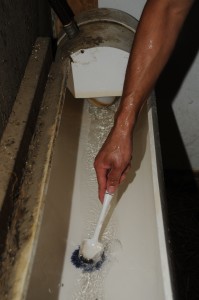Don’t overlook the value of H2O on your farm
Click here for a PDF of this issue of the Goat Gazette.
 Water is an essential nutrient for all animals, including goats, but it can sometimes be overlooked in the bigger picture of livestock health and nutrition.
Water is an essential nutrient for all animals, including goats, but it can sometimes be overlooked in the bigger picture of livestock health and nutrition.
All goats need a continuous supply of fresh, clean water at all times. This can be water from a spring, well, or municipal supply depending on the farm. Regardless of origin, a farm’s water supply should be tested to make sure it doesn’t contain any mineral or organic contaminants, and is free of bacteria like coliform or E. coli.
Overall, goats are more particular about water quality than other livestock, so cleanliness and freshness is very important to ensure goats are consuming enough water. Some goats are also sensitive to water temperature. For dairy goats in particular, a water temperature of 15°C(59°F) is ideal; their water consumption will drop off if the water is below 5°C(41°F).
How much water do goats need?
Daily water consumption will vary, depending on the size and age of the goats, their ration, feed intake, and the weather. On average:
- A 50 kg (110 lb.) doe or buck needs about 9.5 litres (2.1 gallons) of water per day.
- Kids consume about 7.7 litres (2 gal.) per day.
- Lactating does need an additional 1.9 litres of water per litre of milk they produce (0.5 gal. per gal. of milk produced), with an average intake of approximately 13.2 litres (3.5 gal.) daily.
- Goats on high protein ration feed will drink more water, consuming 3.1 to 3.7 kg of water per 1 kg of dry matter (1.4 to 1.7 lb. of water per 1 lb. of dry matter).
Some best management practices for good water quality and quantity on your goat operation
Here are some best management practices to ensure your goats are getting the quality and quantity of water they need, both for animal welfare and for optimal production:
- A farm’s watering system should be able to deliver water to various locations around the property. This includes barn areas and pens (breeding, meat, dairy), working pens, kidding pens, buck housing, isolation pens and pastures.
- Access to natural water can be given to goats on pasture, as long as the water source is fresh. A water hole should be fenced with a crushed stone path leading up to it to reduce erosion of soil and manure into the water. If a natural spring is used, it should be fenced off and water piped into a trough located underneath a cover of some kind.
- Troughs, bowls and other drinking locations should be of sizes suitable to the groups of goats using them to ensure both that goats can access the water and that there is a sufficient quantity available. They should be designed to keep water clean, unsoiled and fresh.
- All watering equipment should be cleaned thoroughly and regularly.
- Provide an alternate water source for any outages lasting more than 12 hours.
- Ensure your water lines, buckets, troughs and waterers are in good working order and keep up with necessary repairs.
- Take steps to protect your watering system from freezing in the winter – through extra insulation or heaters with built-in thermostats, for example.
For more information or resources for the goat industry, please visit our resources page or contact us.
